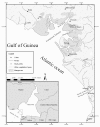Assessing forest products usage and local residents' perception of environmental changes in peri-urban and rural mangroves of Cameroon, Central Africa
- PMID: 22146073
- PMCID: PMC3261808
- DOI: 10.1186/1746-4269-7-41
Assessing forest products usage and local residents' perception of environmental changes in peri-urban and rural mangroves of Cameroon, Central Africa
Abstract
Background: Deforestation is one of the most ubiquitous forms of land degradation worldwide. Although remote sensing and aerial photographs can supply valuable information on land/use cover changes, they may not regularly be available for some tropical coasts (e.g., Cameroon estuary) where cloud cover is frequent. With respect to mangroves, researchers are now employing local knowledge as an alternative means of understanding forest disturbances. This paper was primarily aimed at assessing the mangrove forest products usage, along with the local people's perceptions on environmental changes, between Littoral (Cameroon estuary) and Southern (mouth of the Nyong River and Mpalla village) regions of Cameroon.
Methods: The data from both locations were obtained through conducting household interviews and field observations.
Results: In the Cameroon estuary (Littoral region), 69.23% of respondents (mostly elders) could distinguish two to four mangrove plants, whereas the informants (65.45%) in the mouth of the Nyong River and Mpalla village (mostly young people interviewed from the Southern region) are familiar with only one or two commonly found mangroves. Also, more respondents from the Cameroon estuary are depending on mangroves for fuelwood (Rhizophora spp.) and housing (Rhizophora spp., Avicennia germinans (L.) Stearn and Nypa fruticans (Thumb.) Wurmb.) purposes, in contrast to Nyong River mouth and Mpalla village. Although local people perceived wood extraction as a greater disruptive factor, there are several causes for mangrove depletion in the Cameroon estuary. Among others, over-harvesting, clear-felled corridors, sand extraction and housing were found important. Furthermore, a decline in mangrove fauna composition (in terms of fishery products) was recorded in the Littoral as well as Southern regions. However, the causes of such perceived negative changes were not similar in both cases.
Conclusions: Findings of this study highlight the need to improve sustainable management of the mangrove ecosystems through afforestation (in large impacted areas), selective removal of senescent tree stems and branches (in little damage stands), regulating sand extraction and housing activities, and creating awareness and law enforcement.
Figures





Similar articles
-
Commercial activities and subsistence utilization of mangrove forests around the Wouri estuary and the Douala-Edea reserve (Cameroon).J Ethnobiol Ethnomed. 2009 Nov 17;5:35. doi: 10.1186/1746-4269-5-35. J Ethnobiol Ethnomed. 2009. PMID: 19919680 Free PMC article.
-
Analysing ethnobotanical and fishery-related importance of mangroves of the East-Godavari Delta (Andhra Pradesh, India) for conservation and management purposes.J Ethnobiol Ethnomed. 2006 May 8;2:24. doi: 10.1186/1746-4269-2-24. J Ethnobiol Ethnomed. 2006. PMID: 16681845 Free PMC article.
-
[Effects mangrove conversion to pasture on density and shell size of two gastropods in the Turbo River Delta (Urabá Gulf, Caribbean coast of Colombia)].Rev Biol Trop. 2012 Dec;60(4):1707-19. Rev Biol Trop. 2012. PMID: 23342523 Spanish.
-
[Costa Rica mangroves: the north Pacific].Rev Biol Trop. 2009 Sep;57(3):473-88. Rev Biol Trop. 2009. PMID: 19928448 Review. Spanish.
-
Functional Traits of Terrestrial Plants in the Intertidal: A Review on Mangrove Trees.Biol Bull. 2021 Oct;241(2):123-139. doi: 10.1086/716510. Epub 2021 Oct 8. Biol Bull. 2021. PMID: 34706208 Review.
Cited by
-
Contrasting Effects of Historical Sea Level Rise and Contemporary Ocean Currents on Regional Gene Flow of Rhizophora racemosa in Eastern Atlantic Mangroves.PLoS One. 2016 Mar 10;11(3):e0150950. doi: 10.1371/journal.pone.0150950. eCollection 2016. PLoS One. 2016. PMID: 26964094 Free PMC article.
-
Ethno-botanical study of the African star apple (Chrysophyllum albidum G. Don) in the Southern Benin (West Africa).J Ethnobiol Ethnomed. 2012 Oct 9;8:40. doi: 10.1186/1746-4269-8-40. J Ethnobiol Ethnomed. 2012. PMID: 23046832 Free PMC article.
-
Is Matang Mangrove Forest in Malaysia sustainably rejuvenating after more than a century of conservation and harvesting management?PLoS One. 2014 Aug 21;9(8):e105069. doi: 10.1371/journal.pone.0105069. eCollection 2014. PLoS One. 2014. PMID: 25144689 Free PMC article.
-
Vulnerability to climate change of mangroves: assessment from cameroon, central Africa.Biology (Basel). 2012 Nov 6;1(3):617-38. doi: 10.3390/biology1030617. Biology (Basel). 2012. PMID: 24832511 Free PMC article.
-
Does mangrove vegetation structure reflect human utilization of ecosystem goods and services?iScience. 2023 May 11;26(6):106858. doi: 10.1016/j.isci.2023.106858. eCollection 2023 Jun 16. iScience. 2023. PMID: 37255662 Free PMC article.
References
-
- Ehrlich PR, Mooney HA. Extinction, substitution, and ecosystem services. BioScience. 1983;33:248–254. doi: 10.2307/1309037. - DOI
-
- Houghton RA. The worldwide extent of land-use change. BioScience. 1994;44:305–313. doi: 10.2307/1312380. - DOI
-
- Dobson AP, Bradshaw AD, Baker AJM. Hopes for the future: restoration ecology and conservation biology. Science. 1997;277:515–522. doi: 10.1126/science.277.5325.515. - DOI
-
- Valiela I, Bowen JL, York JK. Mangrove forests: one of the world's threatened major tropical environments. Bioscience. 2001;5:807–815.
Publication types
MeSH terms
LinkOut - more resources
Full Text Sources
Miscellaneous

